
|
CFCC Class
The first notice of the Central Florida Community College class was in an article in the Star Banner newspaper on December 10, 2006, in the Travel Section. "Darwin, Evolution, and the Galapagos Islands" Course No. BSC 2931 was a 6-week course being offered in the summer semester of 2007, beginning May 8, to study the island history and Charles Darwin's theory and writings. Travel to the Galapagos was scheduled by Holbrook Travel for June 16 through June 25, exploring the islands during the day and spending nights on Nemo I sailing catamaran. Cost of the trip was $3,347 per person in an "air-conditioned" cabin (double occupancy), meals, round-trip transportation from Orlando, local guides, and snorkeling. Extras were airport taxes of $32, nonrefundable deposit of $250 to CFCC for reservation, fee for three-hour course was $67.94 per credit hour, and one-time $20 application fee for registering at CFCC. Balance due March 13, 2007. Day 1 - Saturday, June 16, 2007. A friend drove me to the Lake Limo pickup at 11:15 a.m. Round trip to Orlando was $74, plus tips. Breakfast on the plane was rolled up something like pizza and orange juice. The plane lunch from Panama City was a beef sandwich and orange juice. |
![]()
|
Guayaquil, Ecuador
On landing at the airport in Guayaquil, Ecuador, we were met by Fernando at the airport and escorted to the Grand Hotel. He would be our guide while we were in Ecuador. Early breakfast at hotel with eggs, hard croissants, yogurt, and sausage, and then escorted back to the airport for the flight to Baltra. My water bottle spouted on the plane to Baltra due to air pressure. Landing on Baltra, we were met by Gabriel, our official naturalist guide for the entire island journey. Then we were transferred to the Nemo I by panga. |
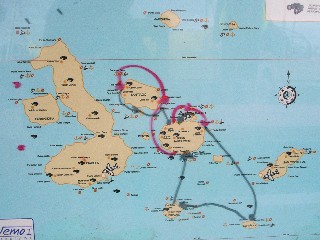 Galapagos Islands route |
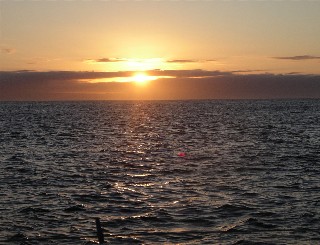 Sunrise |
![]()
|
Nemo I - Sailing Catamaran "Nemo I" - ten-day trip starting Saturday, June 25, 2007, through Monday, June 25, 2007. The boat accommodates twelve passengers. Entry to the cabins was down a ladder, set of steps, or through a hatch. The boat helped me appreciate the efficiency of my GTRV. The air conditioning was non-existent, but there were little fans located in the bunk area that helped a little with the humidity. Each day, our schedule was posted on a bulletin board and our route indicated on a wall map located by the outside dining area.
The Galapagos Islands consist of 19 islands, more than 40 islets, 54 land sites, and 64 marine sites, located about 600 miles off the coast of Ecuador. |
![]()
| Day 2 - Sunday, June 17, 2007. - Lunch on the Nemo was grilled fresh tuna fish, and dinner was green spinach soup. Besides our class group, passengers included a young couple from Vancouver, Canada; an East Indian couple from Great Britain; and a German lady from Quito, Ecuador. On a wet landing that afternoon on Bachas Beach on Santa Cruz Island, we saw frigate birds, blue footed boobies, lava gulls, marine iguanas, stilt, flamingoes, purple jellyfish washed up on beach, biting flies, Sally lightfoot crabs, green spiny sea urchins. That night Gabriel presented a program on Galapagos Islands. |
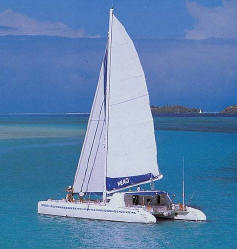 Nemo I |
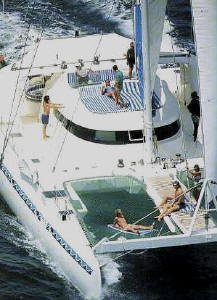 Nemo I |
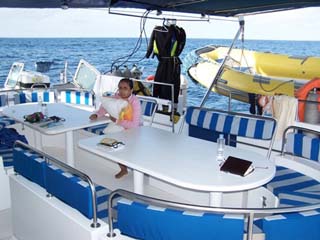 Outside Dining |
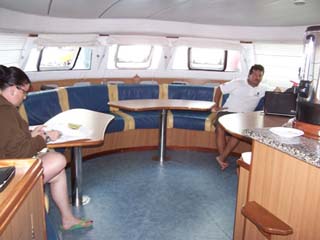 Inside Dining |
![]()
|
Day 3 - Monday, June 18, 2007, walked 6,868 steps (3.24 miles). Learned that the left side of Nemo is "port" and right side is "Starboard." Wake-up call at 6:00 am; dry landing on North Seymore at 6:30 am; breakfast of fruit, cereal, yogurt at 8:30 am; sighted sea turtle off starboard at 9:20 a.m.; snorkeling at 10:00 a.m.; lunch of shrimp, cole slaw with raisins, fruit at 12:30 p.m.; dry landing on South Plaza at 3:00 p.m.; and back on boat at 5:30 p.m.
My underwater camera did not work when snorkeling but I saw sea lions, starfish, and many fish. Some of us got stung by jellyfish. Many sea lions on beach and in water, with many young. Lava lizards, marine iguanas, nesting and courting blue-footed boobies. On the beach were large colonies of sea lions and fur seals, pufferfish, and sea lettuce. These islands have one of the largest populations of land iguanas. Although the islands are situated near the equator, the surrounding water is cooled by the Humboldt current, so I used a full lycra skin with a shorty wetsuit when snorkeling in the cold water. |
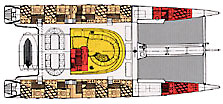 Catamaran Layout |
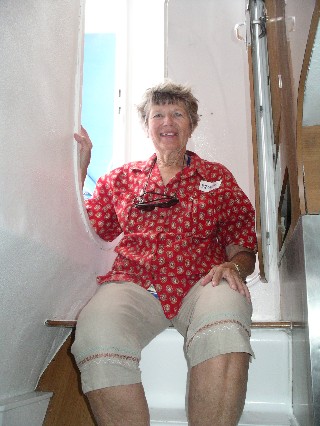 Doorway at top of stairs |
![]()
|
Day 4 - Tuesday, June 19, 2007. 5,923 steps, 2.79 miles.
Early walk after a dry landing. The trail led across large boulders and flat stones. Saw blue-footed boobies, Nazca boobies, albatross, and bird landing field. Photograghed a female carpenter bee, the only bee indigenous to islands. Prickly pear cactus, palo verde, acacia, light beacon, blow hole, marine iguanas, land iguanas, frigate birds. Green sea turtle sighted. Snorkeling and swimming with sea lions. Put up sails on Nemo. Lunch was salmon, long green pasta, pear. Wet landing on white beach. The beaches on different islands were different colors - white, black, green, red. Saw beach morning glory, carpenter bee, butterfly, lava lizard, sea lions. Although I used the Pentax Optio camera most of the time, I took some pictures with Kodak camera. At 3:30 p.m. school of bottle nosed dolphins spotted off starboard. Took over 300 pictures today. |
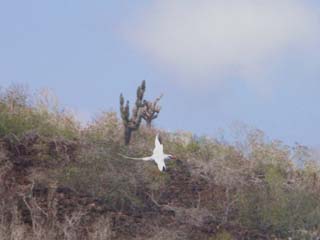 Red-billed Tropicbird |
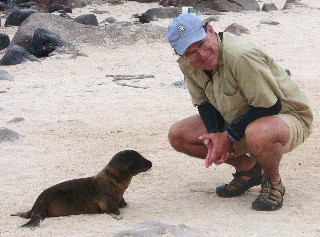 Seal and Gabriel |
![]()
|
Birds - About 140 species of birds have been registered, almost half of which are endemic in the islands. The Galapagos hawk is the largest land bird and is the top of the food chain.
The Waved Albatross is the largest sea bird in the islands, weighs 6 to 9 pounds with a wingspan of 11 feet, and lives 40-50 years. It nests only on Espanola Island (Hood) and uses the high cliffs of Punta Suarez as an airport. Just beyond the colony is a blow hole where we sat to watch the seabirds performing their aerial movements and their less graceful attempts at landing and taking off. |
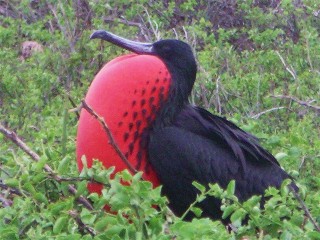 Frigatebird |
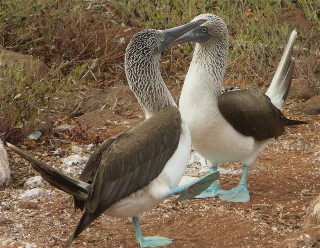 Blue-footed Boobies |
![]()
| Marine Iguanas - are the only sea-going lizards in the world. They have an average size of 2 to 3 feet, can dive down to 36 feet to feed on submerged seaweed, and stay submerged for up to 45 minutes. |
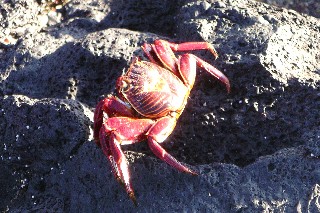 Sally Lightfoot Crab |
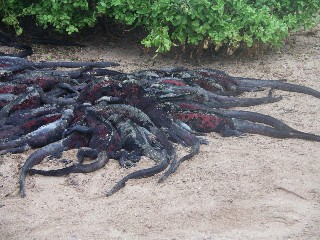 Marine Iguanas |
![]()
|
Floreana Island - Day 5 - Wednesday, June 20, 2007, schedule: 6:30 a.m. - Wake-up; 7:00 a.m. - Breakfast; 8:00 a.m. - Wet landing on Floreana; 9:00 a.m. - Dive; 12:00 noon - Snorkle; 1:00 p.m. - Lunch. At 1:30 p.m. we took an impromtu Panga ride with Gabriel with large (150) school of bottle nose dolphins cavorting around our boat. 2:00 p.m. - Wet landing; 5:00 p.m. - Sail to Santa Cruz.
On the north coast of Floreana is Post Office Bay which contains a barrel that has been changed many times over the years. Whalers and island residents used to leave their mail inside waiting for a captain of any headed to to where the mail was addressed. I put in a card to Larvalbug.com, Austin, Texas, to hopefully be picked up during another trip to the islands next year. Saw Devils' Crown and a rock island where we snorkled with sea turtles. Saw red billed tropic birds, pencil-spined sea urchins, chitons, many fish, flamingos, white checked pintail ducks, great blue heron. |
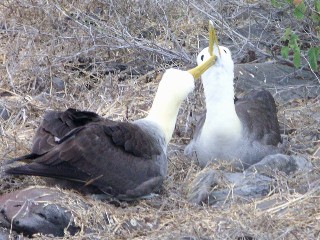 Albatross |
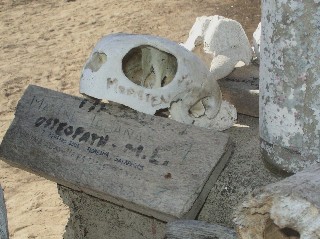 Post Office |
![]()
| Charles Darwin Research Station - Day 6 - Thursday, June 21, 2007 - walked 14,518 steps (6.85 miles) on Santa Cruz Island, including the Highlands, lava tube cave, Puerto Ayora, Charles Darwin Research Center. Tortoises, finches, dark billed cuckoo (Ani). We encountered a herd of cattle on the road during bus ride to highlands. One bus was parked along very bumpy rocky road with flat tire and people walking on road. Lunch on boat was fresh tuna fish. All the meals on the trip were very well planned and appetizing, sometimes including native cuisine. |
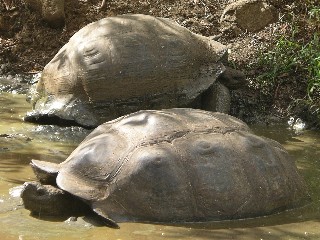 Galapagos Tortoise |
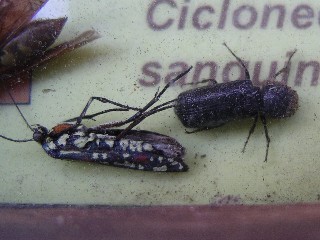 Insects |
![]()
| Puerto Ayora, Santa Cruz - Spent the afternoon in town where I got postage stamps for Val and watched fish cleaners at fish market. Dinner on boat was filet mignon, mushrooms, fries, tomato, green beans, baked banana. Took water taxi to Nemo later in day and had to pronounce the boat as "NA MO" so taxi driver understood what boat to go to. The Nemo left the island at 12:00 midnight. |
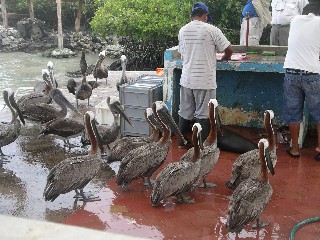 Fish Market |
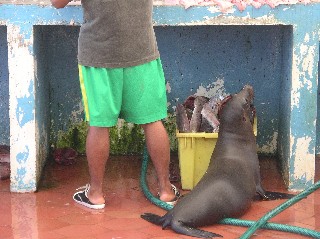 Fish Market |
![]()
|
Bartolome Island - Day 7 - Friday, June 22, 2007 schedule: 6:00 a.m. Wake-up call; 6:30 a.m. - Dry landing at Bartolome; 8:00 a.m. - Breakfast - pancakes, syrup, pineapple, meat slice, cheese, guava juice, yogurt; 9:30 a.m. - Snorkeling from beach; 11:00 a.m. Back on board; 12:00 noon - Lunch; 2:00 p.m. - Wet landing at Puerto Egas with black sand - Sullivan Bay, James Island; 4:00 p.m. - Snorkeling; 5:30 p.m. - Back on board.
Bartolome Island has a 365 step boardwalk leading to the summit where there was a great view of both bays and towards Santiago. This island is famous for the Pinnacle Rock. Missed wake-up call but our alarm went off at 6:15 a.m. On the panga ride we saw a penguin on the rocky shore. 385 steps to top of steps and ramps and boardwalk and gravel paths - to get beautiful view of islands below and the submerged rim of an extinct volcano. Saw various lava formations including Pahoehoe (ropey) and aa, fish, penguins, lava lizards, plants, and took pictures of Pinnacle Rock. Crew members were: Pescadito (cook); Guido (sailor); Jonatan (cabin boy); Henry (captain); Felipo (engineer); Mauricio (second mate); and Gabriel (official guide). |
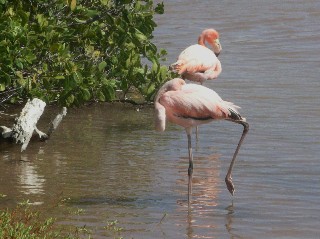 Flamingos |
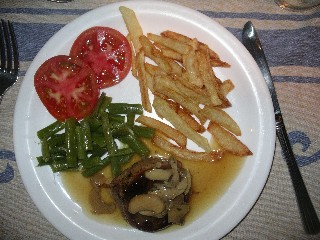 Dinner |
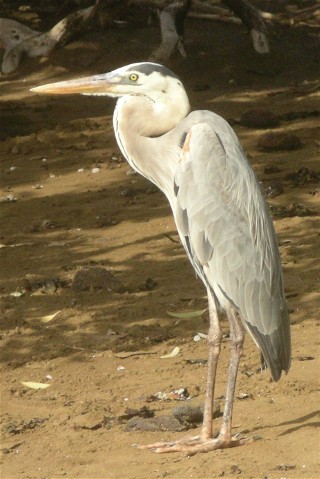 Blue Heron |
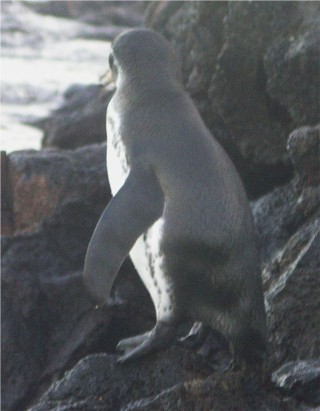 Penguin |
| For snorkeling we were dropped off by Pinnacle Rock to swim around the rock to a beach through under water cliffs and ravines. Many starfish, black muyuyo, and other fish. Lots of waves and jellyfish. Swam around point, back to calmer water. On land, Galapagos shore petunia plants were very plentiful; also white lantana. From beach we walked across loose sand dunes and rock to see a shore with large schools of white-tipped sharks waiting for baby sea turtles to hatch. Fish were right up to the shore. Sea beans and many parts of crabs were strewn on the beach. The beach became rather crowded with other people after our walk across the dunes. |
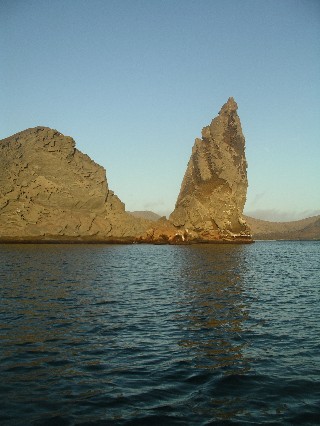 Pinnacle Point |
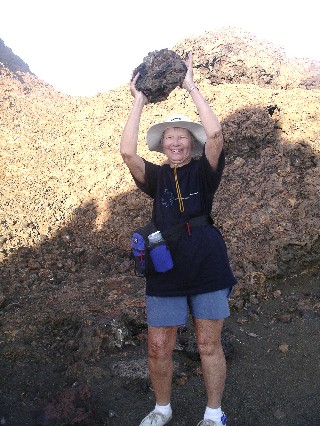 Rock |
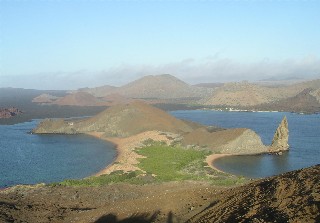 Bartholome Island across Sullivan Bay |
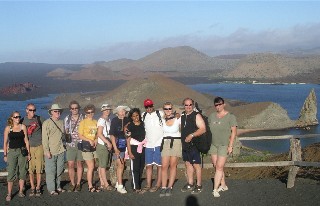 The Group |
![]()
| Rabida - Day 8 - Saturday, June 23, 2007 schedule: 6:45 a.m. - Wake-up call; 7:00 a.m. - Breakfast - scrambled eggs, cut-up hotdogs, banana, yogurt, toast, cheese, grapefruit juice; 8:00 a.m. - Wet landing on Rabida Island - Walk on Rabida red sand - sea lions, pelican colony, blue footed boobies diving in water. Since Rabida has no tortoises or iguanas, the cactus grows from ground up. Walk across lava tubes, coral chunks, and lava flows. |
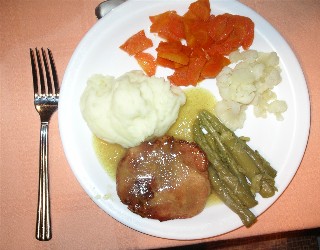 Filet Mignon |
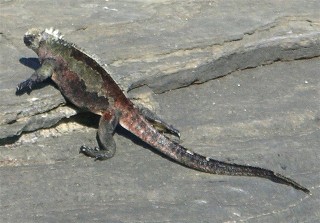 Marine Iguana |
![]()
| Chinese Hat - 10:30 a.m. - Back on board; 12:00 noon - Lunch; 2:00 p.m. - Snorkeling; 2:30 p.m. - Chinese Hat. Walk on beach - white sand made from white coral and lots of black lava rock. Saw many bull sea lions - each had a little cove in the rock cliffs, protected by large breaking waves. There was a baby seal that looked like it was starving. Lots of vegetation and lava tubes and other lava formations. 3:00 p.m. - Wet landing on Sombrero Island (Chino - Chinese Hat off Santiago) |
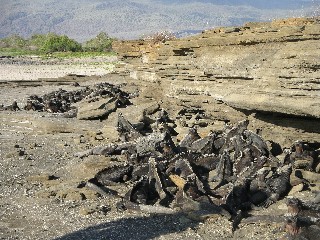 Marine Iguanas |
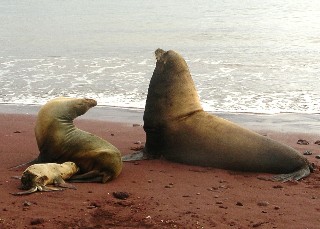 Sea Lions |
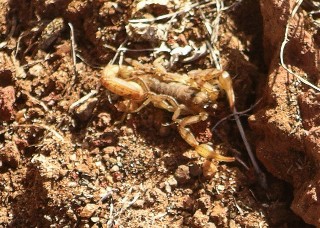 Scorpion |
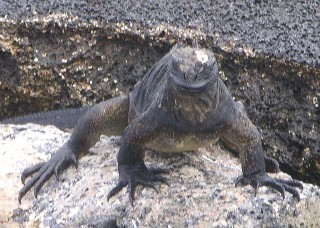 Marine Iguana |
![]()
| Caleta Tortuga Negra - Day 9 - Sunday, June 24, 2007 schedule: 6:00 a.m. - Wake-up call; 6:30 a.m. - Panga ride in Black Turtle Cove (Caleta Tortuga Negra) to see sea turtles and birds; 7:30 a.m. - Breakfast; 8:30 a.m. - Bags out - Baltra; 9:00 a.m. - Departure to Baltra airport; 12:00 noon - TAME (Aero Girl) airway plan leaves Baltra to Guayaquil, Ecuador. Upon landing, we met our guide Fernando who took us to a park in Guayaquil to see a zoo, botanical garden, historical area, and a show with actors, singers, and musicians. |
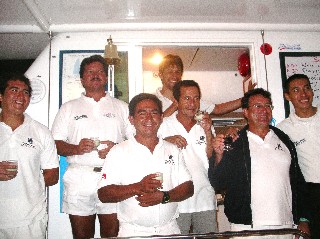 The Crew |
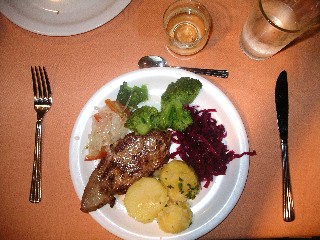 Dinner |
![]()
| Day 9 - Beautiful sunrises and sunsets almost every day. |
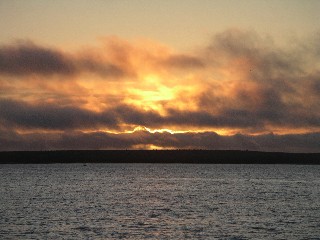 Sunset |
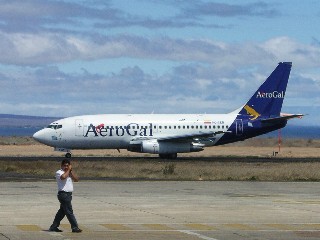 The Plane |
![]()